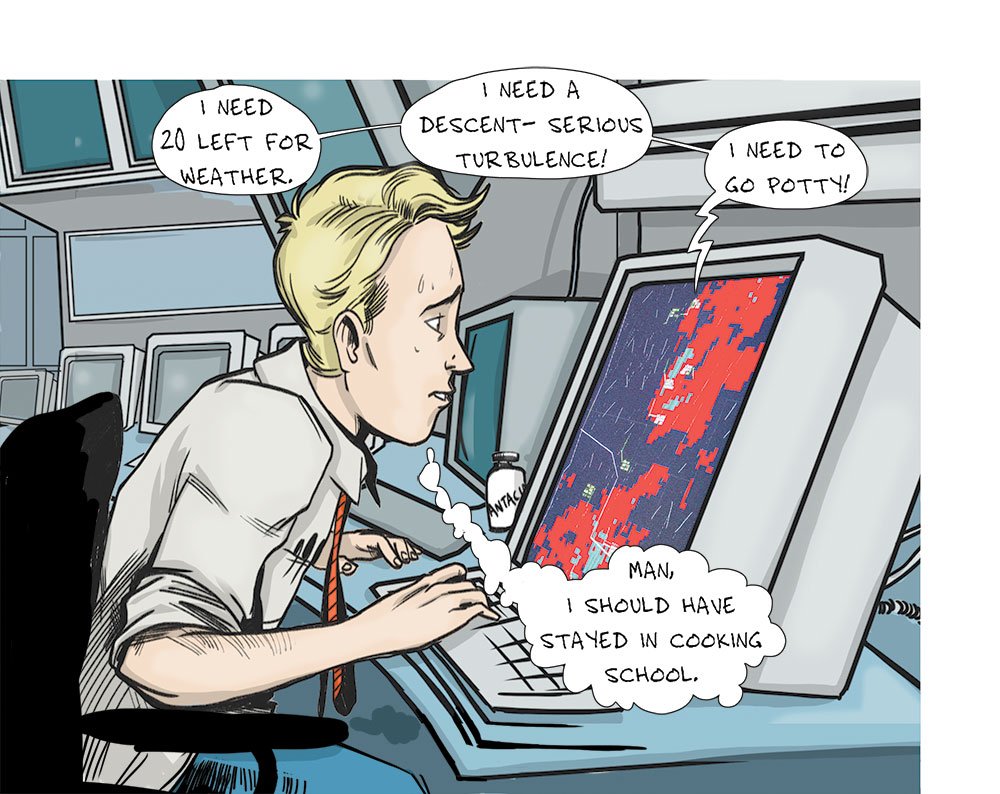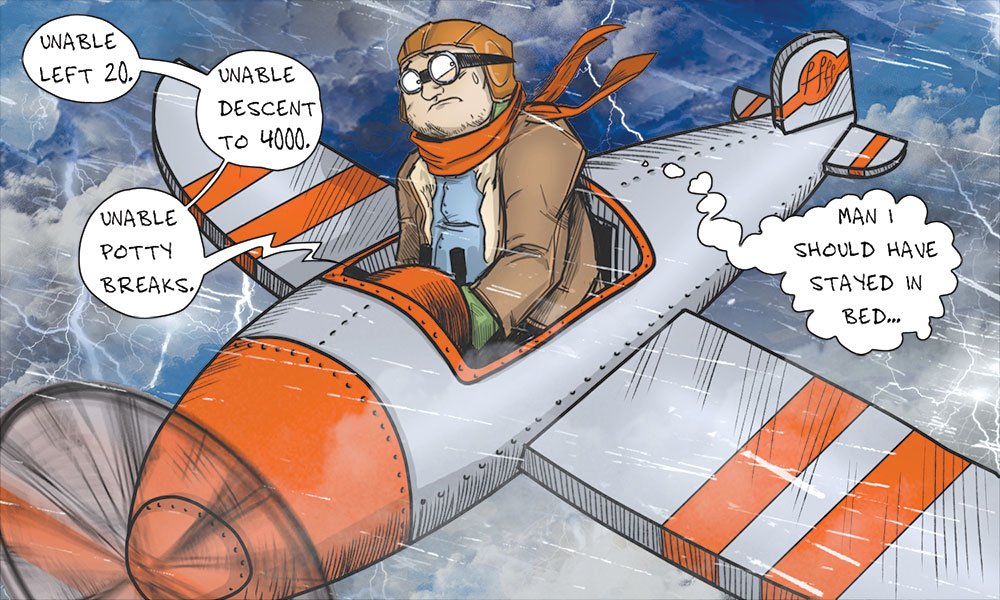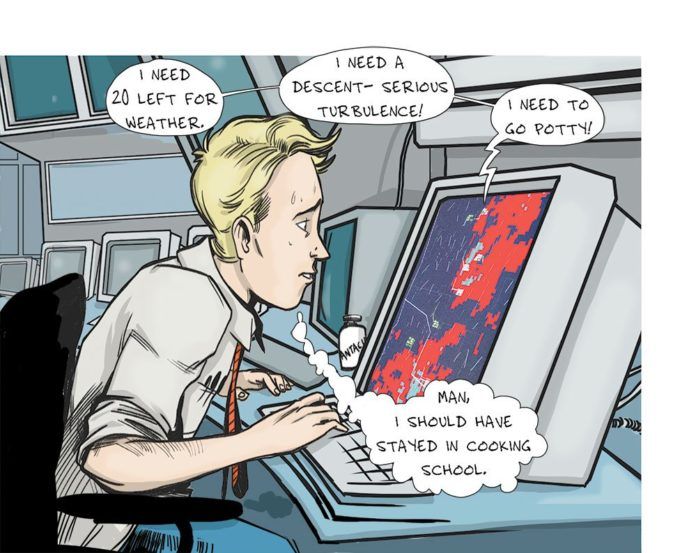When ATC says “unable”
Most controllers want to grant pilot requests. When they decline, it’s not just for amusement or out of lassitude. There can be a lot going on backstage the pilot can’t see.

Judgment is the cornerstone of the air traffic control profession. This basic trait, common among thousands of successful air traffic controllers worldwide, allows controllers to face a variety of situations—including unusual pilot requests—and act appropriately.
Like the folks in the cockpits, a controller relies on situational awareness. He takes a multitude of things into account before approving a pilot’s request, asking himself questions like, “If I approve this, will it create a conflict with another airplane? Will I violate someone else’s airspace? Do I need to coordinate with another controller? Is this request illegal according to my regulations?”
If he doesn’t like the answer to any of the questions above, he may have to disapprove the pilot’s request. The reasons fluctuate between scenarios, but here are some of the more common obstacles that can prompt an “Unable.”
How Much is Too Much?
Workload is a prime factor. When the sky is black with airplanes and a controller is too busy to fully process the ramifications of what the pilot is asking, then he shouldn’t be approving it. Otherwise, he might sink himself deeper into the muck.
This concept is integral to ATC training. Controllers are evaluated not just by how much traffic they can handle, but also by how well they know their personal limits. One of the old salts that I worked with said he’d never recommend an ATC trainee for certification until he’d seen that trainee get so busy he had to call for help. It showed the newbie had recognized he wasn’t superhuman.
Part of that education is learning the time and place to say, “Unable.” I’ve seen ATC trainees bomb their already busy certification checkrides by approving some strange request that cut the thin thread by which they were hanging. When a trainee’s supervisor has to take over because aggressive pilots talked the newbie into a bind, the trainee can forget about getting his ticket punched that day.
Majority Rules
Every Star Trek fan knows the famous Spock quote: “The needs of the many outweigh the needs of the few.” While ATC’s control towers and radar facilities tend to be more 20th-century government issue than 23rd-century science fiction, the meaning still applies: If a pilot’s request is approved, will anyone else be negatively affected?
If I have a line of air carriers ready to go and a Cessna asks if he can practice holding at a fix in the middle of our departure corridor, that’ll be a resounding “No way.” Apologies to the Cessna pilot, but I’m not going to delay hundreds of paying passengers just because he needs to check a box on his flight-training syllabus. The Skyhawk can bore donuts in the sky for a while until the jets depart. Then he can have his proper holding pattern.
It’s not a “GA versus big air carrier” thing. It’s a balancing act between safety, efficiency, and order. If I’ve got two Skyhawks in our active runway’s touch-and-go pattern, and a Delta 757 requests to land on our crossing runway, that’s elementary: By briefly extending a downwind or upwind for each Skyhawk, I can easily build a hole for the Boeing to land between them.
Now let’s change the parameters. What if I have six or seven Skyhawks in the pattern? What if three of them are student solos? Sure, I can opt to scatter my organized pattern into a storm of 360s from inexperienced pilots. I’ll need to clear the Skyhawks out of both the airliner’s arrival path and the path he’ll take if he goes around (always leave an “out”). Because my Ground controller uses that inactive runway as a taxiway, I’ll also need to take it from him and force him to issue hold-short instructions to all aircraft he’s already cleared across it.
Or, I can just say “unable” to the crosswind-runway request and force the 757 to the active. We’re talking about only a few extra flying miles for the big guy, a lot less headache for myself, and far better service for the little guys.
Hold the Line
On occasion, pilots request things that are just downright illegal or unsafe. The controller needs to stand fast, adhere to the rules and protect the pilot from, well, himself.
I once gave an “Unable” to a Bonanza’s request to pass through an active bombing range. He actually argued with me over it! Then there was the King Air on vectors for an ILS who caught a glimpse of his destination airport through a break in the overcast and requested a visual approach, even though the airport was legally IFR. He complained about my “Unable,” too. I had a VFR Citation bizjet ask me for a climb to FL230 to test some onboard systems. For a Citation pilot, he seemed blissfully unaware of Class A airspace requirements and refused an IFR clearance. Sorry dude: “Unable.”
The rules themselves are constantly changing. Just recently the FAA instituted a ban on all opposite direction operations. Up until early August, if our advertised runway was 33 and an aircraft wanted to depart Runway 15, no problem. Now, I can’t approve it even if he’s the only airplane moving for a hundred miles.
However, just because I can’t approve one thing doesn’t mean I can’t find a workaround if the pilot really needs it. Due to our shorter runways and higher summer temperatures, some air carriers will have to leave passengers behind due to weight if they can’t get a specific runway. This means I must temporarily make 15 the active—including coordinating a runway change with the radar guys and cutting a new ATIS. It’s only a couple minutes’ work (twice, as I have to change it back) but it keeps some passengers from having their trip ruined or delayed, so I’m glad to do it. In fact, I just did that very thing this morning.
Dodge and Weave
Nothing generates more pilot requests than adverse weather. When the nastiness rolls into town, we expect the frequencies to go crazy with aircraft needing deviations in headings and altitudes to escape thunderstorms, icing and other phenomena. Controllers are encouraged to give the pilots as much leeway as possible. After all, we’re not the ones careening through the angry atmosphere in a cramped metal tube.
Where it gets tricky is when the pilot’s desired heading or altitude conflicts with other traffic or another controller’s airspace. ATC can only approve things as long as they don’t compound the problem.
Suppose I have a Cirrus and a Cherokee at 10,000 and 8000, respectively, and a Twin Cessna cutting between them at 9000. Each requested deviations around a storm cell. I’ve OK’d them by telling each aircraft, “Maintain [aircraft’s current altitude.] Deviations left or right of course approved. ” That allows each plane to swerve at the pilot’s discretion, while maintaining the 1000-foot vertical separation I’m required to have between IFR aircraft.
Now the Cirrus calls, tension bleeding into his voice, demanding a descent to escape unexpected icing conditions. Well, that I can’t approve, with both the Twin and the Cherokee in the way. I’d lose vertical separation and endanger those pilots. As much as I want to say otherwise, I would have to tell the Cirrus, “Unable.” What if he wants a turn to the west, directly at another controller’s airspace, and my coworker is too busy to answer my coordination call? “Unable.” If I approve any of those, I would get flagged with an operation error or deviation.
However, the Cirrus pilot has the right to declare an emergency and do whatever he deems fit to ensure his own safety. FAR 91.3 says, “In an emergency requiring immediate action, the pilot in command may deviate from any rule” —in this case, his clearance to maintain 10,000—”to the extent required to meet the emergency.” I fully understand that the pilot needs to look out for himself, and if I see him start descending, I’ll be vectoring the other guys out of his way.
Standing Up
Just like pilots, controllers all have different experience levels and tolerances for complexity. Yes, some controllers are too quick on the “unable” trigger. Believe me, they frustrate their ATC brothers and sisters just as much as they annoy pilots. Recalcitrant controllers hinder smooth operation and reflect poorly on the rest of the great controllers making things work.
But understand that for the vast majority of controllers, a justified “unable” is a sign of professional confidence, not weakness. It demonstrates their knowledge of the rules, the best flow of traffic and their own limits given the current situation. Outside these bounds, there is no safety, and that’s what ATC exists to provide.
Tarrance Kramer does his best to grant requests working Tower and Approach somewhere in the southeastern U.S.
PILOT TO ATC: I’m UNABLE, too
You don’t hear a pilot utter the word “unable” very often. In fact, there’s evidence suggesting that it’s not heard often enough, as pilots are sometimes getting into trouble accepting instructions from ATC that perhaps they shouldn’t.

Like pilots, controllers are human and humans make mistakes. Plus, of course, they’re not holding the yoke. So, the first rule of dealing with Air Traffic Control is to never let them tell you to do something you’re not 1) capable and qualified to do, and 2) confident you can accomplish safely.
Case in point: I have a friend who was vectored into a mountain in IMC. He figured it out with the cumulogranite at 12 o’clock and one mile and queried the controller, who gave him one of those “immediate” clearances that resulted in a “deal” for the controller and a “whew!” moment for the pilot.
On the other hand, you can’t go around saying you’re unable when you simply don’t want to accept something. “Unable” should be reserved for those times when you’re, well, unable to accept and execute the instructions safely.
Got the Flick?
For example, if you’re getting vectored to final from downwind, you know you’re going to get at least one (in relaxed airspace) or two or more vectors (in busy airspace) to intercept. With a bit of experience, you understand where you fit into the scheme of things, what’s normal and what to expect from your controller.
Every once in a while, though, the instruction you get from the controller simply feels wrong and doesn’t fit into what you were expecting. Don’t be bashful about questioning it. If it’s correct, even the busiest controllers will confirm it, but if it’s wrong, they will happily fix it. In both cases, though, you will probably be thanked for clarifying.
Take the example in “Your Best-Laid Plans” (June 2012 IFR) that discussed last-minute approach changes. You were told to expect vectors for the ILS to Runway 36, but you realize that the vectors you’re getting are not a good set up. Finally, you get a heading and are cleared for the ILS to Runway 6.
You were kind-of expecting a surprise because you had the big picture and the vectors you were getting weren’t consistent with what you expected. Perhaps you figured out what they were doing and got properly prepared. (It’s easy when you hear the planes in front of you getting the ILS 6.)
However, if you’re not confident you can accept and execute the clearance safely, you’ve got to speak up. An “Unable” works, but the better tactic is following the unable with a reason (if meaningful) and an alternative. “Unable ILS Runway 6. I was told to expect 36, which I can accept, or I’ll need an extra minute or two to prepare for the ILS 6.”
Mine’s Bigger Than Yours
Occasionally you get into an “unable” contest with the controller. If you see some serious weather ahead and you ask to deviate left, the controller may have traffic there and deny it. He offers you a right deviation. From where you sit, 10 degrees left would have been fine, but to go right will require 45 degrees or more and add 50 more miles to your flight. Now it’s time to negotiate.
This can get tricky. Sometimes the controller is saturated and he really doesn’t have the time to work out something different with you. Or, sometimes there are other considerations, like airspace. Most of the time, though, just say what you need and why, then offer to be flexible: “Uhhh, Center, if we go right it’d be a really huge deviation. Going left is a small deviation and a safer direction. Would it help to change altitude?”
You may need to seriously stick to your guns. Years ago I was in a Mooney somewhere in the Southwest. There was a huge, lone cell right over a VOR that defined about a dozen different airways hosting about a thousand planes, all requesting a deviation. The controller was going nuts trying to work it all out. He finally just started saying, “Unable.”
Being ultimately responsible for the safe outcome of this flight, I would not enter the belly of this beast, so I asked for right. “Unable.” I asked for left. “Unable.” I asked for higher or lower with a turn. “Unable.” And he wasn’t being difficult; his airspace was simply that saturated.
Finally, though, I played the trump card and said, “Center, we’re unable to safely proceed on course due to weather.” Implied but unspoken was that the next word out of my mouth would be the ultimate trump card—the “E” word. He moved a couple other planes and made space for our deviation. It wasn’t pretty, but it worked.
What ATC Doesn’t Know
Sometimes it’s not so much “unable” as “awkward.” At work I fly a plane with a 200-knot flap speed, but in busy airspace we frequently get 210-knot speed assignments while vectoring for approach. When we then get “expedite descent,” I respond that I’m unable to expedite at 210 but could come down faster at 200. The point being that you know your personal and aircraft abilities far better than ATC. If you see a better way, offer it.
It’s really a lot like life. It’s most folk’s nature to try to be helpful, which is a lot easier if you understand what’s behind the request. If you can’t do something, simply explain why and negotiate an alternative. It might be better for everybody. But even if the result isn’t ideal, it’ll at least be safe.
Frank Bowlin is an IFR contributing editor and pilot of large and small craft.





